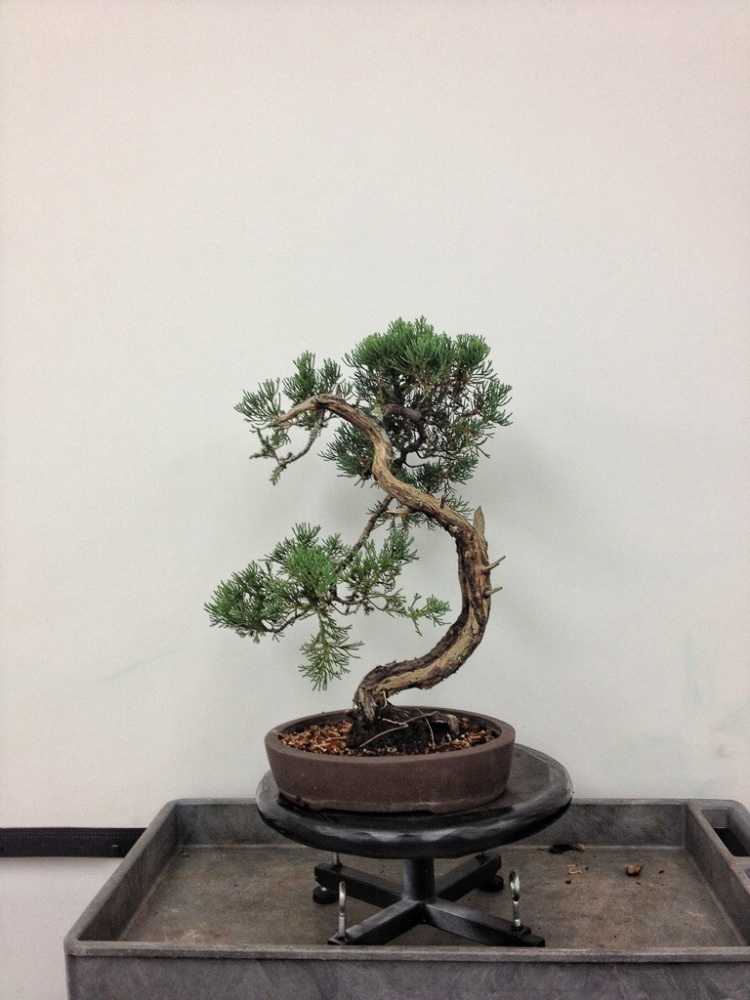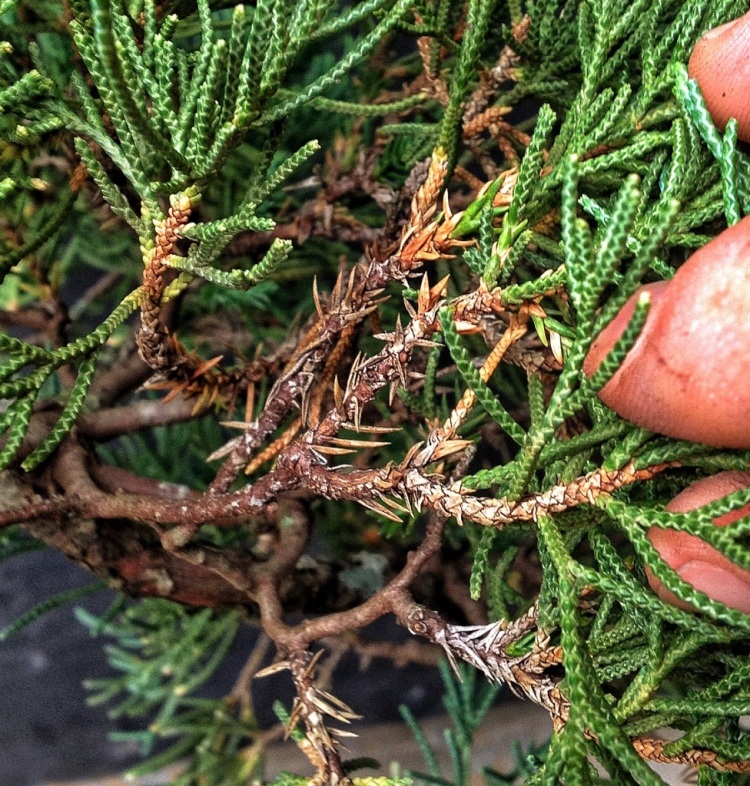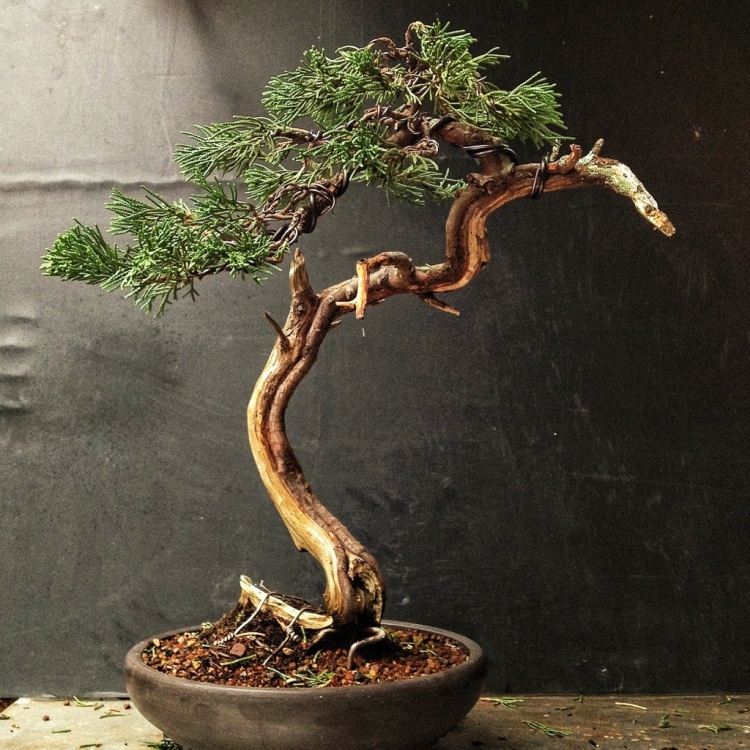This post has taken seven months to complete. Not the writing but the waiting…for the tree.
And, yes, today’s subject is some kind of juniperus chinensis. I thought it was a Parsons juniper but, after doing some research, the Parsons juniper is juniperus davurica “parsonii”. Who knew? We all call this type parsonii. But the j. Davurica has needle foliage as the mature foliage and scale foliage as juvenile foliage. Opposite of most junipers (Unless it was all a typo on the Floridata website or I’m delusional…..I heard that!)
My juniper (whatever it’s called) is one not much loved by the bonsai crowd here because of it’s habit of putting out juvenile foliage at inappropriate times. But it naturally grows with great movement and I think it should be used more.
This is the tree today:

As I said I started this work 7 months ago. In January I repotted the tree and changed the planting angle.
Here is what I started out with. Sorry about the blurry pics


I hemmed and hawed and finally settled on this angle

Before I repotted it, I cleaned up the deadwood and did some pruning


I might have kept the above branch (there’s nothing cooler than a drop branch) but where I cut it was dead halfway through. It actually just broke off.
Some history on the tree; Jason Schley had done a demo for the Central Fl. Bonsai Club many years ago.
I won the tree in a raffle. I kept removing branches that were weak and didn’t grow and I ended up here

The old, dead bark hadn’t been touched so I cleaned it up and brushed the living vein.
The reason you do this is, by removing the old gnarly bark down to the smooth red inner bark, it stimulates the tree to grow more. I’m not sure of the mechanism or why, but it works.
The red under-bark is also cool looking, (like long johns) especially if it’s next to lime-sulfured white deadwood.

The soil it’s potted in is a standard Florida mix.
I’m going to experiment with akadama this time. Or, as I like to call it “aqua dama”

Here in Florida no one really likes it because of how quickly it breaks down. And when it breaks down it kinda turns into a brick.

But I’m not one to just take the general consensus at it’s word. That’s why my tag line is “adamaskwhy ” after all.
It bugs a lot of people that I question so much. You would not believe how much it bugs people. Let me tell you…
Anyway, we will see now how it works here in the Sunshine State.
Fast forward to today

It’s grown pretty well and it’s nice and green.

The bark has even begun to grow back

How is the soil?
Well, it is breaking down-

But that is what it does.
The cycle of akadama is: new soil is very granular and facilitates aggressive root growth when you need it: just after repot. Then as the trees roots fill the pot, the akadama begins to break down and the roots slow down their growth.
It’s using the characteristics of akadama to regulate growth.
In Florida, with the excessive rain, it seems as though the this process is accelerated. I’m probably going to have to repot again next January. Ah well.
Now, though, it needs some style.
First step is cleaning out the weak, dead, and juvenile foliage.
I get this question often:
“The foliage is browning out on my juniper, what do I do?”
If it’s interior growth

And the tips are green and growing

it’s ok,
the browning is just the old needles falling off.
What have we here?
Aha!
Look what I found

Juniper berries!
I was taught to remove the juniper berries when you see them so that they don’t take strength away from the tree.
And also, you must chew on the berry as you work on your tree. You see, the specific psychoactive phytochemicals inherent in a juniper berry expand the projected aura which surrounds us (they do make gin out of it. And of course gin and Jin go together now, don’t they? Words that sound the same are collectively unconsciously interconnected in the great pool we draw from creatively) and we then become one with the tree…..
So, the juniper is now telling me I need to prune out two branches; that these two branches are causing a metaphysical unbalance in the matter and fibre of the ether energy web of this juniper.
Here

And here

Actually, these branches are just blocking the line of the trunk and the Jin.
Snip


The question going through my Florida readers minds now is:
“Why is he working on this juniper in freakin’ July?!”
It’s true that it’s best not to do serious work on junipers in July in Florida.
The sap is running and that makes the bark very susceptible to damage. Wiring and pruning can cause severe dieback if you are not gentle with wiring and judicious when pruning. I plan on being careful.
The lower branch I am removing is directly in the middle of the live vein (there is only one). Sometimes pruning at one point on a vein can kill that vein all the way to the roots.
So what I’m doing could kill the tree.
Hopefully not. To minimize moisture loss I left the branch long with most of the bark attached so that the tree can compartmentalize the, now, dead branch and grow around it. I think it’s strong enough above this to handle the cut; think of a juniper like a siphon hose. If the growing tips are undisturbed then the strength of the tree will continue. If you interrupt the flow you could weaken or kill the tree.
Before I wire I need to clean out the mess inside.

All those dead needles and the juvenile foliage are just in the way of my wire.
This is the before

Like I said, wire gently; try not to crush the fragile bark beneath the wire

The bark is very slippery so try not to do any quick bends in the summer.
And no 45 degree angles either.

A juniper is a tree styled mainly by wire.
Instead of pruning and growing its best to use what you have and move the branches into place where you need them.
Junipers are easy in this way because, if your tree have sufficient branching, you can make a pretty convincing tree on your first styling.
Just distribute the branches

And there you go

This picture shows you the foliage mass
Before

And how I shortened and compacted it, using just wire
After

Aftercare for this tree is to keep the mini fractures in the bark (from the bending while wiring) from drying out.
That means the afternoon rainstorms and humidity should act in my favor.

I top dressed the soil with my mix and put a little fertilizer on it (Milorganite or, as I call it: Biogold, American style…Pride of Milwaukee).
Here’s a question for you
Which angle do you prefer?
This one

Or this one?

And a last progression set for you



I have always been a bonsai admirer, but only recently became involved in design. I have not been crazy about Juniper, but these pics have changed my mind! LOVE the red bark after you removed the rough stuff, making me think of buttonwood. Thinking I might try a juniper at the August Study Group. Would that be appropriate, given the time of year?
LikeLike
We could do a little styling on one next month.
Most juniper bonsai don’t really do much for me either.
To me they’re like a 3 chord rock song or a painting of fruit in a bowl. Cliché.
LikeLike
Thanks for the article. I enjoyed reading it and learned a couple of things.
LikeLike
Thanks Heidi!
LikeLike
I am a professional amateur of my newest favorite hobby…BONSAI. I have already murdered a couple juvenile Junipers, as I had not yet learned that this is a practice of patience last spring. I immediately chopped, drowned, and twisted fresh from the nursery Junipers (amongst others) before doing any research. Anyway, I now have a collection that has been with me for almost a year, and I have learned to love them all.
In particular, my Juniper Procumens, which I purchased from the Internet, is in poorly draining soil. I live in Delaware, and I wanted to know if January is the wrong time to repot my cake-based friend?
There are too many different opinions and rules in Bonsai research, and it seems I am the only one who lives in my region. I also have a 22 year old, root bound Dawn Redwood, and a 10 year old Chinese Elm, which I also has a current soil mix that makes me nervous. Any advice is much appreciated.
Thank you so much!
Mikey Lee G
-Future Bonsai Master
LikeLike
Thanks! I really learnt a lot about shaping a Juniper. Some days back I bought seven Junipers(not from a Bonsai Nursery) as there is not a such place in the city i am living at present. They are lovely but very thin plants. Moreover my heart bleeds, when i think of cutting the unwanted branches! And also i want to convert them in bonsai! As i am living in hill station of North India, Junipers can survive here. Today definitely, i am going to do it. You have really suggested very nice tips.
Thank you very much.
Anita sabharwal.
LikeLike
Do you have any video of that? I’d care to find out more details.
LikeLike
No, I don’t have a video, sorry
LikeLike